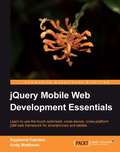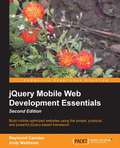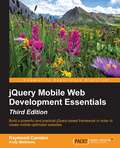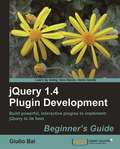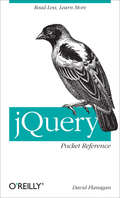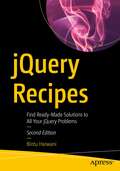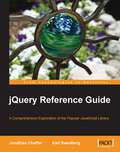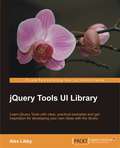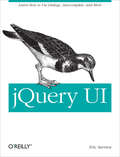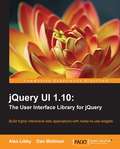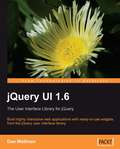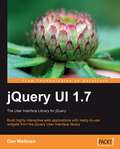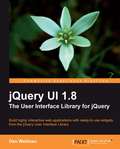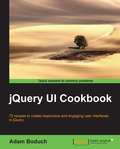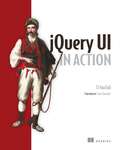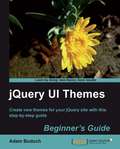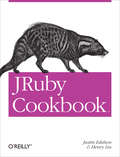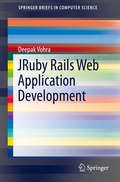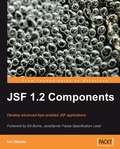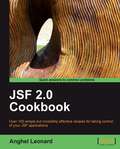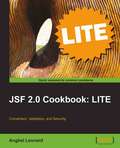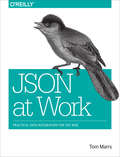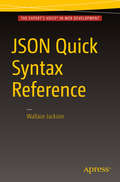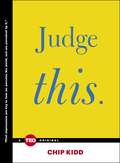- Table View
- List View
jQuery Mobile Web Development Essentials
by Raymond Camden Andy MatthewsThis book will be an introductory guide to the new jQuery mobile framework. It will teach web developers how to use this new framework to develop interactive, cross-platform mobile web applications. If you are a web developer looking to create mobile optimized websites, then this book is for you. Basic knowledge of HTML is required. Some familiarity with JavaScript will help, but is not required.
jQuery Mobile Web Development Essentials, Second Edition
by Raymond Camden Andy MatthewsPacked with practical examples, code, and screenshots, this book will show you how to create mobile optimized sites using the easiest, most practical HTML/JavaScript framework available today.If you are a web developer looking to create mobile optimized websites then this book is for you. Basic knowledge of HTML is required. Some familiarity with JavaScript will help, but is not required.
jQuery Mobile Web Development Essentials - Third Edition
by Raymond Camden Andy MatthewsBuild a powerful and practical jQuery-based framework in order to create mobile-optimized websites About This Book * Build websites with jQuery Mobile that work beautifully across a wide range of mobile devices * Become a competent jQuery Mobile developer and learn the building blocks of jQuery Mobile's component-driven design * This book covers key concepts but with a focus on providing the practical skills required Who This Book Is For This book is for any web developer who is looking to create mobile-optimized websites. Basic knowledge of HTML is required. Minor familiarity with JavaScript would help but is not required. What You Will Learn * Create mobile-optimized sites using simple HTML * Structure your sites so users can browse them on mobile devices * Find out how to work with multiple pages in the JQM framework and embed multiple pages in HTML files * Enhance simple pages using various toolbars * Include mobile-optimized forms for interactive sites * Convert desktop sites into mobile versions * Use HTML5's local storage feature in jQuery Mobile to include persistent client-side storage * Explore the rich sets of widgets and themes available and discover how to modify them for use in your jQuery Mobile site In Detail jQuery Mobile is a HTML5-based touch-optimized web framework. jQuery Mobile can be used to build responsive cross-platform websites and apps for a wide range of smartphones, tablets, and desktop devices. The jQuery Mobile framework can be integrated with other mobile app frameworks such as PhoneGap, IBM Worklight, and more. Introduction to jQuery Mobile explains how to add the framework to your HTML pages to create rich, mobile-optimized web pages with minimal effort. You'll learn how to use jQuery Mobile's automatic enhancements and configure the framework for customized, powerful mobile-friendly websites. We then dig into forms, events, and styling. You'll see how jQuery Mobile automatically enhances content, and will find out how to use the JavaScript API to build complex sites. We'll introduce you to how jQuery Mobile can be themed as well looking into how JavaScript can be used for deep sets of customizations. The examples are ready to run and can be used to help kick-start your own site. Along the way, you will leverage all the concepts you learn to build three sample mobile applications. Style and approach Through a set of easy to follow instructions, we'll show you how to use jQuery Mobile's features one easy-to-use widget at a time. You'll see examples for each feature as well as screenshots to demonstrate what they should look like on a mobile device. You can then take these example files and modify them as you learn to experiment.
jQuery Plugin Development Beginner's Guide
by Giulio BaiThis book takes a beginner's guide approach, giving you step-by-step instructions for creating a number of different jQuery plugins covering most of the common issues one may encounter when working on web pages and sites. It is a practical guide, which will show you how to design and build the most commonly used jQuery plugins.This book is for anyone who wants to have a better understanding of the dynamics of jQuery when plugins come into play, as well as for those who are willing to push jQuery to its limits and develop awesome plugins to use in their websites. A little background information about JS and jQuery cannot harm, but even very beginners can have a chance to be introduced to the wonderful world of jQuery.
jQuery Pocket Reference: Read Less, Learn More (Pocket References Ser.)
by David Flanagan"As someone who uses jQuery on a regular basis, it was surprising to discover how much of the library I'm not using. This book is indispensable for anyone who is serious about using jQuery for non-trivial applications." -- Raffaele Cecco, longtime developer of video games, including Cybernoid, Exolon, and StormlordjQuery is the "write less, do more" JavaScript library. Its powerful features and ease of use have made it the most popular client-side JavaScript framework for the Web. This book is jQuery's trusty companion: the definitive "read less, learn more" guide to the library. jQuery Pocket Reference explains everything you need to know about jQuery, completely and comprehensively. You'll learn how to: Select and manipulate document elements Alter document structure Handle and trigger events Create visual effects and animations Script HTTP with Ajax utilities Use jQuery's selectors and selection methods, utilities, plugins and more The 25-page quick reference summarizes the library, listing all jQuery methods and functions, with signatures and descriptions.
jQuery Recipes: Find Ready-Made Solutions to All Your jQuery Problems
by Bintu HarwaniQuickly discover solutions to common problems, best practices you can follow, and everything jQuery has to offer. Using a problem-solution approach, this book begins with small initial problems that developers typically face while working with jQuery, and gradually goes deeper to explore more complex problems. The solutions include illustrations and clear, concise explanations of the code.You will learn to traverse and manipulate the DOM effectively, understand how to use arrays, iteration, the event model, and implement animation and visual effects. You'll explore how to use plugins and CSS. Using this book and jQuery, your web sites will be more dynamic and lively. This fully updated second edition teaches you modern jQuery techniques including how to traverse and manipulate the DOM, understand the event model, implement animation, and use sliding effects. jQuery Recipes, Second Edition shows you how to avoid wasting development time and solve problems you may face. It is an invaluable reference to keep by your side as you progress in your jQuery development. Start becoming a jQuery pro with jQuery Recipes today.What You'll LearnUnderstand the basics of jQuery and how this library worksLearn how to traverse and manipulate the DOM to your own requirementsExplore jQuery UI techniques including accordion, dialog, slider, date picker and autocompleteWork with popular plugins and CSS to customize and tailor your developmentWho This Book Is ForIdeal for novice or intermediate developers wishing to learn jQuery and have a handy jQuery reference by their side during their development.
jQuery Reference Guide
by Jonathan ChafferThis book is a detailed reference guide, and an invaluable resource for answers to all your jQuery questions. It begins with a real-world jQuery example, which illustrates the structure of a jQuery script. A detailed reference chapter is then presented for each of the main components of jQuery. The book concludes with three reference chapters on jQuery plug-ins: the API for plug-in creation, the Dimensions plug-in, and the Form plug-in. This book is for web developers who want a broad, organized view of all the jQuery library has to offer or a quick reference on their desks to refer to for particular details. The reader needs the basics of HTML and CSS, and should be comfortable with the syntax of JavaScript, but no knowledge of jQuery is assumed. This is not an introductory title and if you are looking to get started with jQuery (or JavaScript libraries in general) then you are looking for Learning jQuery.
jQuery Tools UI Library
by Alex LibbyA practical tutorial with powerful yet simple projects that are quick to implement. This book is aimed at developers who have prior jQuery knowledge, but may not have any prior experience with jQuery Tools. It is possible that they may have started with the basics of jQuery Tools, but want to learn more about how it can be used, as well as get ideas for future projects.
jQuery UI
by Eric Sarrion<p>With the jQuery UI library, you can apply the power and standards of jQuery to user interface design, complete with interactive elements, animation, and themeable widgets. This concise, code-heavy guide demonstrates how to harness interactive features that HTML5 lacks, including tabs, accordions, and dialog boxes. You’ll also learn how to program common but complex tasks, such as managing drag and drop and autocomplete, that make it easier for users to interact with your site.</p>
jQuery UI 1.10: The User Interface Library for jQuery
by Alex Libby Dan WellmanThis book consists of an easy-to-follow, example-based approach that leads you step-by-step through the implementation and customization of each library component.This book is for frontend designers and developers who need to learn how to use jQuery UI quickly. To get the most out of this book, you should have a good working knowledge of HTML, CSS, and JavaScript, and should ideally be comfortable using jQuery.
jQuery UI 1.6: The User Interface Library for jQuery
by Dan WellmanAn example-based approach leads you step-by-step through the implementation and customization of each library component and its associated resources in turn. To emphasize the way that jQuery UI takes the difficulty out of user interface design and implementation, each chapter ends with a 'fun with' section that puts together what you've learned throughout the chapter to make a usable and fun page. In these sections you'll often get to experiment with the latest associated technologies like AJAX and JSON. This book is for front-end designers and developers that need to quickly learn how to use the jQuery UI User Interface Library. To get the most out of this book you should have a good working knowledge of HTML, CSS and JavaScript, and will need to be comfortable using jQuery, the underlying foundation of jQuery UI.
jQuery UI 1.7: The User Interface Library for jQuery
by Dan WellmanAn example-based approach leads you step-by-step through the implementation and customization of each library component and its associated resources in turn. To emphasize the way that jQuery UI takes the difficulty out of user interface design and implementation, each chapter ends with a 'fun with' section that puts together what you've learned throughout the chapter to make a usable and fun page. In these sections you'll often get to experiment with the latest associated technologies like AJAX and JSON. This book is for front-end designers and developers who need to quickly learn how to use the jQuery UI User Interface Library. To get the most out of this book you should have a good working knowledge of HTML, CSS, and JavaScript, and will need to be comfortable using jQuery, the underlying foundation of jQuery UI.
jQuery UI 1.8: The User Interface Library for jQuery
by Dan WellmanAn example-based approach leads you step-by-step through the implementation and customization of each library component and its associated resources. Reference tables of each configuration option, method, and event for each component are provided, alongside detailed explanations of how each widget is used. This book is for front-end designers and developers who need to quickly learn how to use jQuery UI. To get the most out of this book you should have a good working knowledge of HTML, CSS, and JavaScript, and should ideally be comfortable using jQuery.
jQuery UI Cookbook
by Adam BoduchFilled with a practical collection of recipes, jQuery UI Cookbook is full of clear, step-by-step instructions that will help you harness the powerful UI framework in jQuery. Depending on your needs, you can dip in and out of the Cookbook and its recipes, or follow the book from start to finish.If you are a jQuery UI developer looking to improve your existing applications, extract ideas for your new application, or to better understand the overall widget architecture, then jQuery UI Cookbook is a must-have for you. The reader should at least have a rudimentary understanding of what jQuery UI is, and have written some code that uses jQuery UI.
jQuery UI in Action
by TJ VanTollSummaryjQuery UI in Action is a practical guide to using and customizing jQuery UI library components to build rich, user-friendly web applications. By working through numerous engaging examples, you'll move quickly from placing a datepicker on the page to building a complete user interface that includes features like a contact form and shopping cart. You'll master jQuery UI's five main interactions—draggable, droppable, resizable, selectable, and sortable—and learn UI techniques that work across all devices.Purchase of the print book includes a free eBook in PDF, Kindle, and ePub formats from Manning Publications.About the BookYou're only one tag away from richer user interfaces — ‹script src="jquery-ui.js"›. The jQuery UI library simplifies web UI development by providing robust widgets, interactions, and effects you can use immediately. It includes datepickers, autocompletes, tooltips, and a whole lot more. And, jQuery UI's powerful widget factory makes it a snap to customize existing components to meet your needs.jQuery UI in Action is a practical guide to using and customizing jQuery UI library components. By working through numerous examples, you'll quickly master jQuery UI's twelve widgets and five interactions—draggable, droppable, resizable, selectable, and sortable. The engaging examples illustrate techniques that work across all devices. You'll use the widget factory to create reusable plugins and discover jQuery UI's CSS theming system that allows you to create a custom, cohesive look for your sites and your applications.Written for front-end developers and web designers with a basic understanding of jQuery.What's InsideCreate interactions that work on any deviceCustomizable widgets for web and mobile appsWritten by a member of the core jQuery UI teamCovers jQuery UI 1.11About the AuthorA professional web developer, TJ VanToll is a member of the jQuery UI core team.Table of ContentsPART 1 MEET JQUERY UIIntroducing jQuery UIEnhancing UIs with widgetsPART 2 JQUERY UI COREBuilding complex web forms with jQuery UIEnhancing interfaces with layout and utility widgetsAdding interaction to your interfacesCreating rich animations with effectsTheming and styling applications with jQuery UIPART 3 CUSTOMIZATION AND ADVANCED USAGEUsing the widget factory to build stateful pluginsExtending widgets with the widget factoryPreparing your application for productionBuilding a flight-search applicationUnder the hood of jQuery UI
jQuery UI Themes Beginner's Guide
by Adam BoduchThis book is a step-by-step tutorial aimed at beginners to JQuery UI Themes. There is ready-for-use sample code explained with essential screenshots for better and quicker understanding.This book is for web application developers and CSS designers who want a better understanding of how to build themes for the jQuery UI toolkit. The reader should have a basic working knowledge of JavaScript and why it is used in web applications. Experience with jQuery UI and a general working knowledge of CSS will speed things along but aren't a requirement. Readers can use this book as a starting point to familiarize themselves with the jQuery UI widget details.
JRuby Cookbook
by Justin Edelson Henry LiuIf you're interested in JRuby, you probably don't need a turorial on Ruby, Rails, or Java -- you just need to know how to get things done. This Cookbook offers practical solutions for using the Java implementation of the Ruby language, with targeted recipes for deploying Rails web applications on Java servers, integrating JRuby code with Java technologies, developing JRuby desktop applications with Java toolkits, and more. Using numerous reusable code samples, JRuby Cookbook shows you how to: Install and update JRuby on Windows, Mac OS X, and Linux, and IDEs such as NetBeans and Eclipse Package and deploy Rails apps on Java Servlet containers and Java EE application servers, including JBoss, Tomcat, and GlassFish Integrate Ruby and Rails applications with popular Java EE technologies such as JMS, JMX, JPA, Spring, and Hibernate Develop desktop and client applications with cross-platform Java UI technologies and toolkits such as Swing, SWT, and Java 2D Maximize the flexibility of your testing and build environment, using both existing Java-based tools such as Ant and Maven and newer Ruby-based tools such as Rake, Raven, and Buildr The JRuby interpreter combines Ruby's simplicity and ease of use with Java's extensive libraries and technologies, a potent blend that opens new possibilities for Ruby, Rails, and Java. This Cookbook helps you take full advantage of JRuby's potential. "The JRuby Cookbook is an excellent book for any polyglot who is trying to bridge the gap between Java and Ruby. It provides solutions to specific problems developers face in both their development and testing environments, along with the applications they're building." -- Bob McWhirter, Research & Prototyping, Red Hat Middleware
JRuby Rails Web Application Development
by Deepak VohraThis SpringerBrief explains how to create a Rails web application with JRuby, a 100% Java implementation for Ruby. This brief demonstrates how Oracle® WebLogic servers and JBoss® application servers deploy the JRuby application, how JRuby runs on the Java® Virtual Machine, and how JRuby is the basis for popular websites including LinkedIn, Oracle Mix, and Mingle. The Oracle® database and Oracle® MySQL database are used as the basis for the JRuby Rails application. Chapters also cover enabling Flash, developing the JRuby application using Ruby syntax, and deploying applications through Java EE WAR. Hands-on and practical, this SpringerBrief is designed for web developers and researchers interested in JRuby. It is also a useful guide for advanced-level students interested in creating a new web application.
JSF 1.2 Components
by Ian HlavatsThis book is a practical, hands-on guide to learning JavaServer Faces components based on a fictitious computer hardware e-commerce application. It adopts an example-driven approach focused on solving common web application development tasks using a wide range of JSF components from today's most popular JSF component libraries. Each chapter covers a different JSF component library and includes dozens of examples complete with Java source code listings, JSF markup, screenshots, and developer tips. If you are a professional web application developer interested in learning JavaServer Faces having an intermediate to advanced level of Java programming experience and a good understanding of HTML, CSS, and JavaScript, this book is for you. A working knowledge of Java classes, interfaces, annotations, and generics, Java Collections Framework, JavaBeans API, Java Database Connectivity (JDBC), Java Servlets/JSP, Java Authentication and Authorization Service (JAAS), Java Persistence API (JPA), Enterprise JavaBeans (EJB), the Apache Tomcat web container, the JBoss AS 4.2 application server is assumed. Experienced JSF professionals will also find this book useful as a quick reference and "how to" guide.
JSF 2.0 Cookbook
by Anghel LeonardThe JSF 2.0 Cookbook contains step-by-step instructions for JSF users to build desktop-style interfaces in their own web applications. The book is designed so that you can refer to it chapter by chapter, or you can look at the list of recipes and read them in no particular order. This book is for two types of audience: Newcomers who know the basics of JSF but are yet to develop real JSF applications., JSF developers who have previous experience but are lacking best practices and a standard way of implementing functionality
JSF 2.0 Cookbook: LITE
by Anghel LeonardPractical, hands-on "Cookbook" approach. Full of clear, step-by-step instructions that you can apply straight away. Written for people who want to get maximum results without lots of background and theory reading. JSF developers who want to work with validators, converters and security features of JSF. You don't need any prior knowledge of JSF to use these recipes.
JSON at Work: Practical Data Integration for the Web
by Tom MarrsJSON is becoming the backbone for meaningful data interchange over the internet. This format is now supported by an entire ecosystem of standards, tools, and technologies for building truly elegant, useful, and efficient applications. With this hands-on guide, author and architect Tom Marrs shows you how to build enterprise-class applications and services by leveraging JSON tooling and message/document design.JSON at Work provides application architects and developers with guidelines, best practices, and use cases, along with lots of real-world examples and code samples. You’ll start with a comprehensive JSON overview, explore the JSON ecosystem, and then dive into JSON’s use in the enterprise.Get acquainted with JSON basics and learn how to model JSON dataLearn how to use JSON with Node.js, Ruby on Rails, and JavaStructure JSON documents with JSON Schema to design and test APIsSearch the contents of JSON documents with JSON Search toolsConvert JSON documents to other data formats with JSON Transform toolsCompare JSON-based hypermedia formats, including HAL and jsonapiLeverage MongoDB to store and access JSON documentsUse Apache Kafka to exchange JSON-based messages between services
JSON Quick Syntax Reference
by Wallace JacksonThis compact quick scripting syntax reference on JSON covers syntax and parameters central to JSON object definitions, using the NetBeans 8. 1 open source and Eclipse IDE software tool packages. JSON Quick Syntax Reference covers the syntax used in the JSON object definition language, logically organized by topical chapters, and getting more advanced as chapters progress, covering structures and file formats which are best for use with HTML5. Furthermore, this book includes the key factors regarding the data footprint optimization work process, the in-lining of . CSS and . JS files, and why a data footprint optimization work process is important. What you'll learn What is and how to use the Object Definition Syntax supported in JSON What comprises a JSON content production workflow What are the concepts and principles behind the JSON Object Definitions How to use JSON code snippets and apply them in your web applications How to utilize NetBeans, Android Studio and Eclipse IDEs for your JSON coding What are and how to use the key factors regarding the data footprint optimization work process, the in-lining of . CSS and . JS files And, why a data footprint optimization work process is important Who this book is for Primary: Website Developers, Android Application Developers, User Interface Designers, HTML5 OS Application Developers, HTML5 e-Learning Content Creators, HTML5 eBook Authors, HTML5 OS iTV Programmers, Android TV Programmers. Secondary: Blackberry Developers, Windows Developers, iOS Developers, Multimedia Producers, Rich Internet Application (RIA) Programmers, HTML5 Game Designers, Teachers, Educators.
Jt's Conversations on True Basic: Becoming Acquainted with Basic Through Windows (2nd Edition)
by ChircoThis book started as a collection of lecture notes created for the Rutgers course 198:110 during the spring and fall of 1987. This course was, and still is, a course that introduces students to computers--culminating in a few intense weeks of learning to program in BASIC. While this publication does not contain the complete series of notes, it has a very focused purpose--concentrating on the Macintosh computer and the True BASIC programming language.
Judge This: The Terrorist's Son, The Mathematics Of Love, The Art Of Stillness, The Future Of Architecture, Beyond Measure, Judge This, How We'll Live On Mars, Why We Work, The Laws Of Medicine, And Follow Your Gut (TED Books)
by Chip KiddA fun, playful look at the importance of first impressions--in design and in life--from acclaimed book designer Chip Kidd.First impressions are everything. They dictate whether something stands out, how we engage with it, whether we buy it, and how we feel. In Judge This, renowned designer Chip Kidd takes us through his day as he takes in first impressions of all kinds. We follow this visual journey as Kidd encounters and engages with everyday design, breaking down the good, the bad, the absurd, and the brilliant as only someone with a critical, trained eye can. From the design of your morning paper to the subway ticket machine to the books you browse to the smartphone you use to the packaging for the chocolate bar you buy as an afternoon treat, Kidd reveals the hidden secrets behind each of the design choices, with a healthy dose of humor, expertise, and of course, judgment as he goes. Judge This is a design love story, exposing the often invisible beauty and betrayal in simple design choices--ones most of us never even think to notice. And with each object, Kidd proves that first impressions, whether we realize it or not, have a huge impact on the way we perceive the world.
